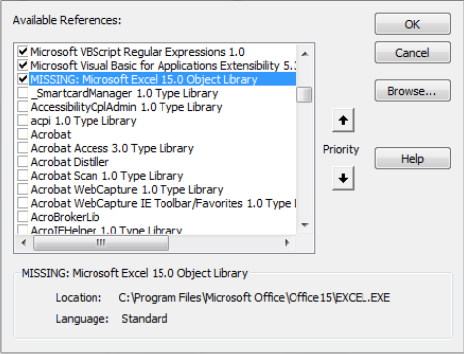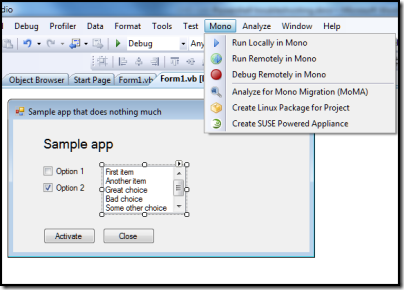
- VISUAL STUDIO OBJECT BROWSER DISSAPEARED UPDATE
- VISUAL STUDIO OBJECT BROWSER DISSAPEARED ANDROID
- VISUAL STUDIO OBJECT BROWSER DISSAPEARED DOWNLOAD
- VISUAL STUDIO OBJECT BROWSER DISSAPEARED WINDOWS
Fixed an issue with Crash Recovery that would show all details as “?”. The Copy function of the Debugger call stack only copied the selected stack item. When describing a table with a long multi-line comment, the column list could be invisible. The Unicode header (UTF8 BOM) for export files could be incorrect for some system locales. Some controls could be incorrectly scaled when the Monitor scaling was changed. The Find form buttons are now disabled if no other window is active. The Register form fields could be blocked. An existing Difference Viewer Window will now be updated when comparing the same file or object. The Difference Viewer will now open at the same line as the current editor if applicable. When viewing a column value with an external tool, no error was displayed if the tool fails. The Test Window SQL Output grid did not clear the sort indicators when executing a new query. Find & Replace no longer overrides previously entered search text when selecting text in the editor. A “Show docking animation” preference has been added. The Git status of files in subdirectories were not always up-to-date in the File Browser. Reopening a Workset immediately after closing it did not show the last changes. Template popup menu could be empty (after long time or hibernate). File Browser and window version control status were not updated after File > Save As. Column aliases in View DDL did not use quotes for mixed case column names. 
 PL/SQL Beautifier will now align exception declarations with variable declarations. Load Desktop, Crash Recovery and Load Workset will not retry failed connections. Editor search hits were not always immediately visible when too far to the right. The Find dialog could incorrectly copy text selected in the editor. The User Defined Tools “Execute” and “Help” button did not work. Report results could not be copied with Ctrl-C. A startup delay could occur when the default printer was not accessible. The “Test” function on Oracle 18 and later now correctly declares %ROWTYPE parameters.
PL/SQL Beautifier will now align exception declarations with variable declarations. Load Desktop, Crash Recovery and Load Workset will not retry failed connections. Editor search hits were not always immediately visible when too far to the right. The Find dialog could incorrectly copy text selected in the editor. The User Defined Tools “Execute” and “Help” button did not work. Report results could not be copied with Ctrl-C. A startup delay could occur when the default printer was not accessible. The “Test” function on Oracle 18 and later now correctly declares %ROWTYPE parameters. VISUAL STUDIO OBJECT BROWSER DISSAPEARED DOWNLOAD
Version 14.0.1 users can download 14.0.3 here.
VISUAL STUDIO OBJECT BROWSER DISSAPEARED UPDATE
Note: downloading an update through Check Online Updates in version 14.0.1 did not always work. The Object Browser information can be refreshed any time by using the Refresh button on the Edit toolbar, the Shift+Alt+R shortcut or the context menu (refreshing does not work during the test execution). However, the structure of running processes can change any time. Instead the Browser analyzes memory to get the information it will display when it is launched, and also whenever you open up a branch in the object hierarchy. The information shown in the Object Browser cannot be updated continuously in either of the Browser panes without taking up significant CPU time. - Applications whose objects TestComplete accesses using the Text Recognition technology. - Applications whose objects TestComplete accesses via the MSAA or UI Automation engine. - XUL UI objects in Gecko-based applications. - Web applications in Internet Explorer or the WebBrowser control. - Delphi or C++Builder Open Applications. Objects that Open Applications expose to TestComplete are displayed with a glyph that indicates the type of the given Open Application: VISUAL STUDIO OBJECT BROWSER DISSAPEARED ANDROID
Open Applications (except for Visual C++ Open Applications, Android Open Applications and applications that use the MSAA or UI Automation technology) are displayed with the icon to the right of their names in the Object Tree. To view them, enable the Show hidden members option in the Engines - General Options dialog. Hidden properties are not displayed in the Object Browser window by default. TestComplete also supports specific technologies that allow you to get information about the user interface of applications of any type (for instance, Microsoft Active Accessibility (MSAA) and UI Automation). Such applications instrumented for white-box testing under TestComplete are called Open Applications. Exposed objects, properties and methods will also be available to your tests. If your application is created with one of the supported development tools, TestComplete will expose its internal elements to the Object Browser. TestComplete supports a number of popular development tools, such as Microsoft Visual Studio, Delphi, C++Builder and others.
VISUAL STUDIO OBJECT BROWSER DISSAPEARED WINDOWS
Controls on these windows are marked with. Windows of black-box applications are displayed with the glyph.

The system processes are shown with the icon. However, you will see more if the process has windows, even if they are not visible because windows are registered with the operating system. If it is a non-visible process, you will see fairly little. When you expand a node in the Object Browser, the amount of detail you see in the branches and in the Object Browser pages on the right depends on the nature of the process.







 0 kommentar(er)
0 kommentar(er)
